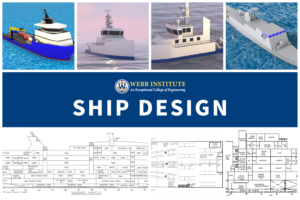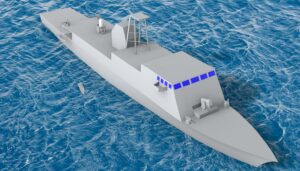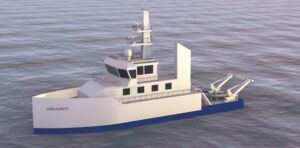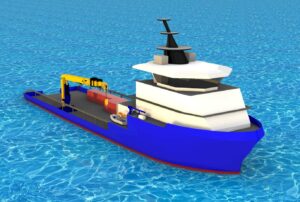As a part of Professor Bradley D.M. Golden’s ’99 Ship Design 1 (SD1) class, the juniors spent the first two-and-a-half months of the spring semester preparing their first complete concept designs.
Using the knowledge they’ve gained in their nearly three years studying at Webb and the experiences from their winter work periods to date, this was the students’ first opportunity to apply the naval architecture and marine engineering principles they’ve studied including stability, ship’s structures, main machinery systems, auxiliary systems, resistance and propulsion, and electrical engineering.
Working in small groups of three and four, the students selected one of the vessel types and took their first couple of spins around the design spiral to prepare vessel concept designs. To help make the project as realistic as possible, members of industry familiar with each of the vessel types helped prepare the statements of design requirements that each of the designs had to meet. To challenge the students even further, one or two “curveballs” were thrown into each design statement to make the students think long and hard about how they would achieve their objectives.
At the end of the spring semester, the students presented their final designs to their fellow students, faculty, and members of industry who served as part of an evaluation team. After three years at Webb, the Junior class can now say with confidence that they’re familiar with the design process and are well on their way to joining the fields of naval architecture and marine engineering.
Spring 2022 projects - The Class of 2023
M/V Steve Irwin
Designers: Jonathan Allen, Eric Heilshorn, Spencer Margosian, Kasey Kennedy
Vessel Type: Expedition Cruise Ship
Standard Mission:
The Steve Irwin is a vessel capable of bringing you to the edges of civilization to experience adventures the untouched world has to offer. From snorkeling in the Galapagos to polar plunges in the Arctic, guests simultaneously experience luxury and explore the unknown while accompanied by revered experts in the fields of photography and exploration.
USS Minesota
Designers: Kyle Murphy, Gabriel Allen, Alex Resio, Jacob Dillistin
Vessel Type: Minesweeping Countermeasure Mothership
Standard Mission:
Provide a new method for handling mine countermeasure operations with the use of mine countermeasure units-remote/autonomous (MCU-RAS). The use of MCU-RAS in mine countermeasures allows the coverage of larger minefield areas as compared to traditional minesweepers while minimizing the risk to personnel and naval assets.
R/V Coelacanth
Designers: Victoria Kim, Alexander Lytle, Lorenzo Pensabene, Natalie Webb
Vessel Type: Oceanographic Research Vessel
Standard Mission:
Our research vessel is intended to meet the demand for small and efficiently crewed research vessels that are suitable for coastal and near-shore research projects. Its purpose is to provide a platform to support a wide range of general marine and ocean sciences that is cost efficient and environmentally friendly.
Tug Life
Designers: George Hambleton, Mark Reed, Erin Postma, Nate Phillips
Vessel Type: Salvage Tug
Standard Mission:
Tug Life is a DNV classed, biodiesel fueled salvage tug operating in the Caribbean and along the eastern seaboard of North and South America. Its primary purpose is to respond to maritime emergencies and provide salvage, towing, and support services. In addition to a 150 MT bollard pull, it is also equipped with oil spill recovery equipment, and FiFi Class 1 external firefighting equipment.
Porpoise
Designers: Jack Kirk, Kira Shaw, Cole Matthes, Deck Uttmark
Vessel Type: Seismic Survey Vessel
Standard Mission:
The primary objective of the Porpoise is to investigate the formation of rocks, oceanographic trenches, and other subsea geology that could affect the lives of humans and the marine environment through seismic survey.
SOV Atlas
Designers: Si Cong Chen, Thomas Giannuzzi, Luke Sullivan, Adriana Torres Rodriguez
Vessel Type: Support Operation Vessel
Standard Mission:
The Support Operation Vessel (SOV) will provide a stable platform and accommodations for servicing offshore wind farms during initial installation, assisting with the construction and installation of the individual wind turbines, and continued maintenance over the windfarm’s operation. It will be Jones Act compliant and operate year-round up to 100 miles offshore along the U.S. East Coast.







